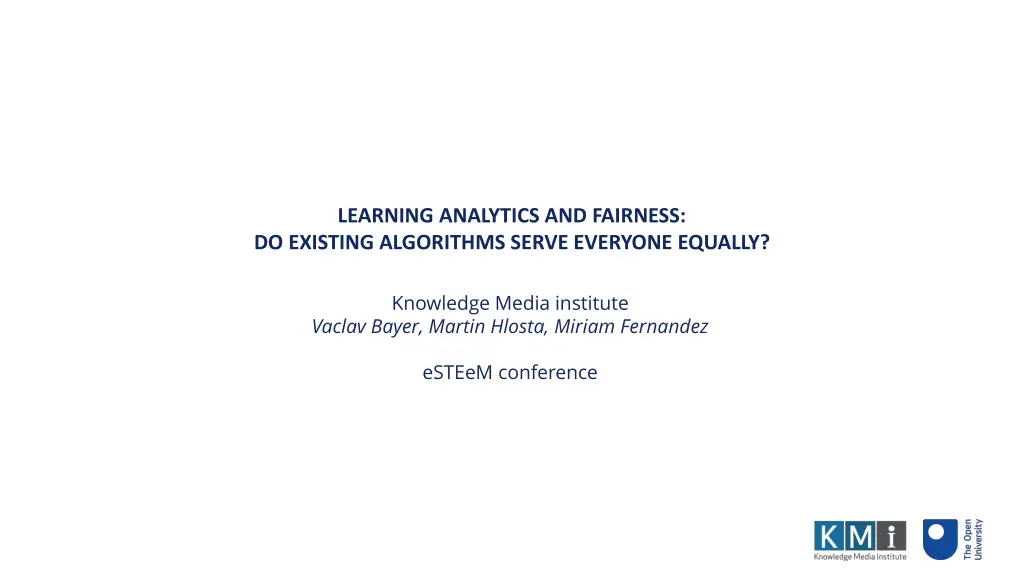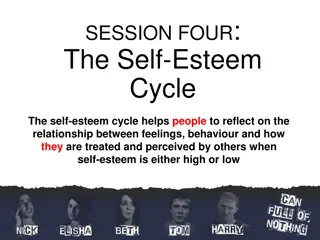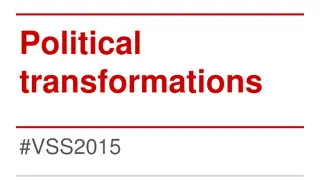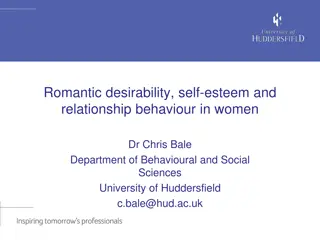
Learning Analytics and Fairness in Existing Algorithms
Explore the disparities in academic outcomes among different student groups, such as Black, Asian, Minority Ethnic, female, and disabled students in universities. The study delves into the effectiveness of existing Learning Analytics (LA) prediction models in serving all students equally, shedding light on the importance of fairness and accuracy in educational algorithms.
Download Presentation

Please find below an Image/Link to download the presentation.
The content on the website is provided AS IS for your information and personal use only. It may not be sold, licensed, or shared on other websites without obtaining consent from the author. If you encounter any issues during the download, it is possible that the publisher has removed the file from their server.
You are allowed to download the files provided on this website for personal or commercial use, subject to the condition that they are used lawfully. All files are the property of their respective owners.
The content on the website is provided AS IS for your information and personal use only. It may not be sold, licensed, or shared on other websites without obtaining consent from the author.
E N D
Presentation Transcript
LEARNING ANALYTICS AND FAIRNESS: DO EXISTING ALGORITHMS SERVE EVERYONE EQUALLY? Knowledge Media institute Vaclav Bayer, Martin Hlosta, Miriam Fernandez eSTEeM conference
LEARNING ANALYTICS AND FAIRNESS: DO EXISTING ALGORITHMS SERVE EVERYONE EQUALLY? PROBLEM UniversitiesUK and AdvanceHE report a 13% awarding gap for Black, Asian and Minority Ethnic (BAME)1,2 Black, Asian and Minority Ethnic (BAME) students at the Open University put more effort and spend more time studying, they are, however, less likely to complete, pass or achieve an excellent grade compared to White students4 Similar effect found for female students in STEM. Disabled students are less likely to obtain a degree-level qualification (21.8%) compared to non-disabled students3 OU s goal to reducethe existing good module pass gap between BAME and White students from 19.3% (2017/2018) to 9.3% (2024/2025)6, Office for Students (24.4% -> 14.4%)7 Are the predictions fair and accurate for everyone equally? 7% higher chances to pass modules for students if their tutors used OUAnalyse Predictive Learning Analytics at the Open University5 Vaclav Bayer, Martin Hlosta, Miriam Fernandez vaclav.bayer@open.ac.uk https://orcid.org/0000-0001-8953-6335
LEARNING ANALYTICS AND FAIRNESS: DO EXISTING ALGORITHMS SERVE EVERYONE EQUALLY? METHODOLOGY 32,538 unique students White (87.7%), Black (3.3%), Asian (3.7%), Rest (Mixed, Other, Refused, Unknown) (5.3%); Female (71.8%) x Male (28.2%); Non-disabled (74.2%) x Disabled (25.8%); 14 largest modules (4 faculties) RQ1: Do existing LA prediction models work equally effectively for all types of students? RQ2: Do the LA population-specific prediction models perform better? Exclusion of protected attributes (Fairness through unawareness) Metrics: False Positive Rate (FPR) - students erroneously predicted to Not Submit False Negative Rate (FNR) - students erroneously predicted to Submit (more severe error as students most likely don t receive needed support) AUC - model's overall accuracy Different configurations of the model Training 2018J, Predicting 2019J Protected attributes: Ethnicity, Disability, Gender Model: Gradient Boosting Model Vaclav Bayer, Martin Hlosta, Miriam Fernandez vaclav.bayer@open.ac.uk https://orcid.org/0000-0001-8953-6335
LEARNING ANALYTICS AND FAIRNESS: DO EXISTING ALGORITHMS SERVE EVERYONE EQUALLY? RQ1: Do existing LA prediction models work equally effectively for all types of students? All data Model Female eval. Disabled eval. White eth. eval. Black eth. eval. Training on all data A separate evaluation of each subgroup is made Comparison Majority vs Minority The model advantages White ethnicity in terms of AUC and FPR. Black and Rest groups have a higher chance to be correctly identified as being at risk of not submitting The model is less accurate and presents a higher FNR for Female students The model is less accurate (3%) and presents a higher FPR for Disabled students Vaclav Bayer, Martin Hlosta, Miriam Fernandez vaclav.bayer@open.ac.uk https://orcid.org/0000-0001-8953-6335
LEARNING ANALYTICS AND FAIRNESS: DO EXISTING ALGORITHMS SERVE EVERYONE EQUALLY? RQ2: Do the LA population-specific prediction models perform better? White eth. data. White eth. eval. Model Black eth. data. Black eth. eval. Model ... ... Disabled eval. Disabled stud. data Model The models are trained and evaluated only on a specific population of students Compared to the evaluation of corresponding Baseline population Only White students sub-population specific model performed better in terms of AUC. The rest of the models otherwise presented lower AUC and higher both error rates. Vaclav Bayer, Martin Hlosta, Miriam Fernandez vaclav.bayer@open.ac.uk https://orcid.org/0000-0001-8953-6335
LEARNING ANALYTICS AND FAIRNESS: DO EXISTING ALGORITHMS SERVE EVERYONE EQUALLY? Fairness through unawareness Exclude ethnicity attr. All data Model Rest eth. eval. White eth. eval. Black eth. eval. Asian eth. eval. The protected attributes are excluded during the model training process The evaluation of each subgroup separately A comparison with Baseline evaluation results are made to discover the influence of unawareness on the metrics The unaware model seems to improve AUC & FNR for Asian, Rest, Non-Disabled, and worsens these for Black and White students In terms of FPR it s opposite No significant change for the gender protected attr. Vaclav Bayer, Martin Hlosta, Miriam Fernandez vaclav.bayer@open.ac.uk https://orcid.org/0000-0001-8953-6335
LEARNING ANALYTICS AND FAIRNESS: DO EXISTING ALGORITHMS SERVE EVERYONE EQUALLY? RESULTS Existing LA models discover inequalities in terms of accuracy and fairness across ethnicities, gender and disability Higher AUC for White, Male, and Non-Disabled students. Highest FPR: Black, Male, Disabled Highest FNR: Asian, Female, Non-disabled Individual models worsen AUC and error rates (apart of White stud.) Excluding protected attr. can improve AUC and error rates for some subgroups Different methods can help to reduce inequalities on different levels, but the solution is not systematic, and therefore, different adaptations and definitions of fairness are needed. Vaclav Bayer, Martin Hlosta, Miriam Fernandez vaclav.bayer@open.ac.uk https://orcid.org/0000-0001-8953-6335
References 1. https://www.universitiesuk.ac.uk/policy-and-analysis/Pages/equality-diversity-inclusion.aspx 2. https://www.advance-he.ac.uk/guidance/equality-diversity-and-inclusion/student-recruitment-retention-and-attainment/degree-attainment- gaps 3. https://www.ons.gov.uk/peoplepopulationandcommunity/healthandsocialcare/disability/bulletins/disabilityandeducationuk/2019 4. Nguyen, Q., Rienties, B., Richardson, J.T.: Learning analytics to uncover inequality in behavioural engagement and academic attainment in a distance learning setting. Assessment & Evaluation in Higher Education 45(4), 594 606 (2020) 5. Hlosta M., Herodotou C., Bayer V., Fernandez M. (2021) Impact of Predictive Learning Analytics on Course Awarding Gap of Disadvantaged Students in STEM. In: Roll I., McNamara D., Sosnovsky S., Luckin R., Dimitrova V. (eds) Artificial Intelligence in Education. AIED 2021. Lecture Notes in Computer Science, vol 12749. Springer, Cham. https://doi.org/10.1007/978-3-030-78270-2_34 6. The Open University (2020). OU Access and Participation Plan 2020-2025, http://www.open.ac.uk/about/wideningparticipation/sites/www.open.ac.uk.about.wideningparticipation/files/files/OU%20Access%20and%20P articipation%20Plan%202020-2025.pdf 7. Office For Students (2018). A new approach to regulating access and participation in English higher education: Consultation outcomes, https://www.officeforstudents.org.uk/media/546d1a52-5ba7-4d70-8ce7-c7a936aa3997/ofs2018_53.pdf






















